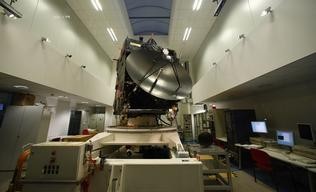Rosetta Probe set to rendezvous with Comet C-G
| dweisman | | Aug 05, 2014 06:49 PM EDT |
(Photo : REUTERS/Ralph Orlowski ) Sscale model of the Rosetta spacecraft is pictured at the European Space Operations Centre (ESOC) in Darmstadt January 20, 2014. Comet-chasing spacecraft Rosetta woke from nearly three years of hibernation to rendezvous with comet 67P/Churyumov-Gerasimenko and land a probe on it in an unprecedented manoeuvre. The model, a working copy of the Rosetta spacecraft in orbit, serves as a training instrument for the flight control team.
It's been a decade and billions of space miles, but now the European Space Agency is about to make an impact with its Rosetta spacecraft set to rendezvous with a comet on Wednesday.
Small, yet powerful, Rosetta has been hurtling at nearly 35,000 miles per hour through space since 2004 at a cost of USD$1.7 billion, or 1.3 billion euros. A sequence of 10 thruster firings that began several months ago have slowed it's pace to a bit more than two miles per hour to allow for a close encounter with Comet 67P/Churyumov-Gerasimekno, also known as Comet C-G.
Like Us on Facebook
The comet is three times farther than Earth from the sun, about 335 million miles or so. Named for the Rosetta Stone that was used to decipher hieroglyphics, it's rock and ice and may offer valuable insight into the beginnings of the solar system more than 4.5 billion years ago. The comet has a surface temperature of minus 70 Celsius, almost 95 degrees Fahrenheit.
The 2.5 mile-wide Comet C-G with Rosetta about 60 miles away on its tail is headed toward the sun. A 62-pound landing craft called Philae in honor of the Egyptian Nile River island on which the Rosetta Stone was found, will touch down on the comet in November.
Spacecraft and lander are designed to continue the mission through early 2015. The intention is to retrieve and examine material from the comet. Scientists want to take a long look at the comet to determine how it actually works over a long period of time. Previous missions to comets have executed brief fly-bys and crash landings with the latest mission actually collecting surface samples of comet dust now being examined on Earth.
Rosetta dates back to the early 1990s. After its 2004 launch, the tiny spacecraft picked up speed by orbiting the sun several times, then accelerating further by catapulting courtesy of gravity fields on Mars and the Earth. As a power-saving measure, it hibernated for two years before being revived in January for its date with Comet C-G.
Scientists will use several techniques to identify the comet's composition. They will examine the comet's ice and look for amino acids, a building block for life.
Tagsspace exploration, comets, NASA, european space agency, rosetta probe, life in space, Science, comet c-g
©2015 Chinatopix All rights reserved. Do not reproduce without permission
EDITOR'S PICKS
-

Did the Trump administration just announce plans for a trade war with ‘hostile’ China and Russia?
-

US Senate passes Taiwan travel bill slammed by China
-

As Yan Sihong’s family grieves, here are other Chinese students who went missing abroad. Some have never been found
-

Beijing blasts Western critics who ‘smear China’ with the term sharp power
-

China Envoy Seeks to Defuse Tensions With U.S. as a Trade War Brews
-

Singapore's Deputy PM Provides Bitcoin Vote of Confidence Amid China's Blanket Bans
-

China warns investors over risks in overseas virtual currency trading
-

Chinese government most trustworthy: survey
-

Kashima Antlers On Course For Back-To-Back Titles
MOST POPULAR
LATEST NEWS
Zhou Yongkang: China's Former Security Chief Sentenced to Life in Prison

China's former Chief of the Ministry of Public Security, Zhou Yongkang, has been given a life sentence after he was found guilty of abusing his office, bribery and deliberately ... Full Article
TRENDING STORY

China Pork Prices Expected to Stabilize As The Supplies Recover

Elephone P9000 Smartphone is now on Sale on Amazon India

There's a Big Chance Cliffhangers Won't Still Be Resolved When Grey's Anatomy Season 13 Returns

Supreme Court Ruled on Samsung vs Apple Dispute for Patent Infringement

Microsoft Surface Pro 5 Rumors and Release Date: What is the Latest?










